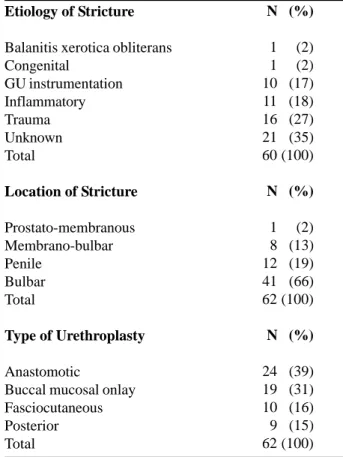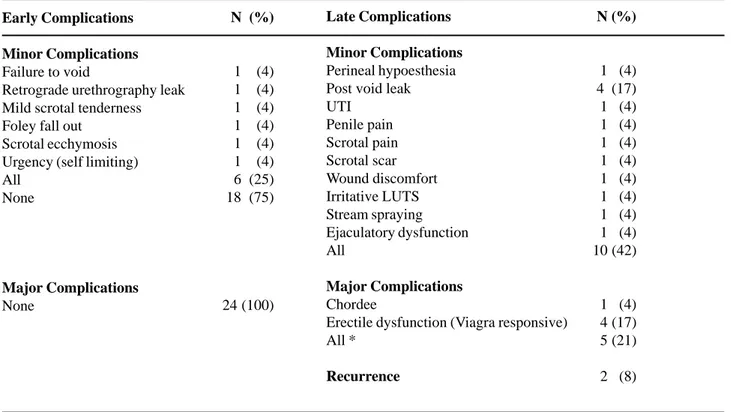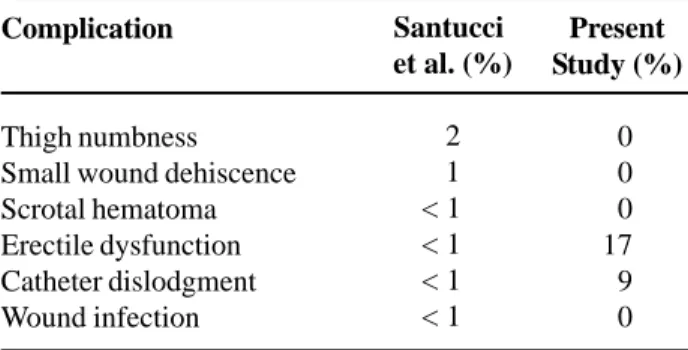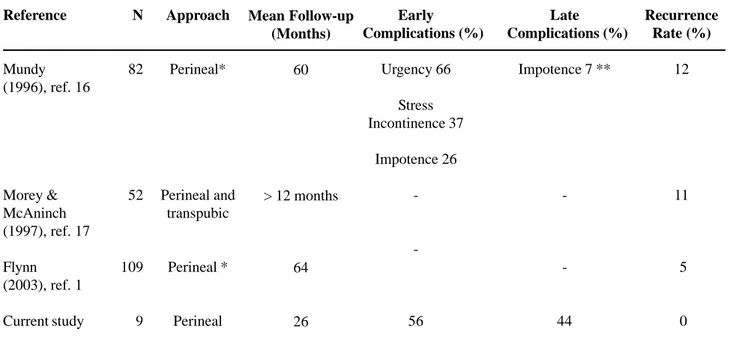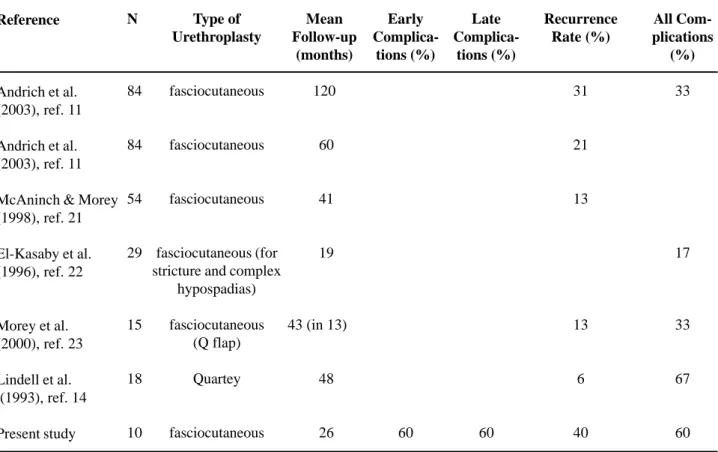EXTENDED COMPLICATIONS OF URETHROPLASTY
HOSAM S. AL-QUDAH, RICHARD A. SANTUCCI
Departments of Urology, Detroit Receiving Hospital and Wayne State University School of Medicine, Detroit, Michigan, USA
ABSTRACT
Introduction: An extensive study of complications following urethroplasty has never been published. We present 60 urethroplasty patients who were specifically questioned to determine every possible early and late complication.
Materials and Methods: Retrospective chart review of urethroplasty patients between Au-gust 2000 and March 2004. An “open format” questioning style allowed maximal patient reporting of all complications, no matter how minor.
Results: 60 patients underwent 62 urethroplasties (24 anterior anastomotic, 19 buccal mu-cosal and 10 fasciocutaneous, 9 posterior anastomotic) with mean follow-up of 29 months. Early complications occurred in 40%, but only 3% were major (rectal injury and urosepsis). Early minor complications included scrotal swelling, scrotal ecchymosis and urinary urgency. Late complications occurred in 48%, but only 18% were significant (erectile dysfunction, chordee and fistula). Late minor complications included a feeling of wound tightness, scrotal numbness and urine spraying. Fasciocutaneous urethroplasty caused the most significant complications, and buccal mucus urethro-plasty the least, while also resulting in the lowest recurrence rate (0%).
Conclusions: Serious complications after urethroplasty (3% early and 18% late) appear similar to those reported elsewhere, but minor bothersome complications appear to occur in much higher numbers than previously published (39% early and 40% late). While all the early complications were resolved and most (97%) were minor, less than half of the late complications were resolved, although most (82%) were minor. These complication rates should be considered when counseling urethro-plasty patients, and generally tend to support the use of buccal mucosal onlay urethrourethro-plasty as it had the lowest rate of serious side effects.
Key words:urethra; urethral stricture; surgery; complications
Int Braz J Urol. 2005; 31: 315-25
INTRODUCTION
Urethroplasty has excellent success rates against urethral stricture (1-5), that far exceed that seen with direct visual internal urethrotomy (DVIU) and dilation (6,7). The total impact of urethroplasty on the patient is unknown as an extensive study of complications after urethroplasty has not yet been published. We present our experience with 60
ure-throplasty patients especially questioned so as to de-termine every possible early and late complication.
MATERIALS AND METHODS
mucosal graft, 10 fasciocutaneous onlay flap, and 9 posterior anastomotic urethroplasties. In 2 patients, multiple simultaneous procedures were performed: 1 patient had a proximal buccal graft plus distal fasciocutaneous flap, another had a proximal anasto-motic plus distal fasciocutaneous flap. The patient mean age was 46 years (18 to 78 years) with a mean follow-up of 29 months (10 to 53 months).
Patients’ records were reviewed regarding stricture cause, stricture length determined by retro-grade urethrogram (RUG), location, type of urethro-plasty, early complications, results of postoperative urethrogram, postoperative flow rates, late compli-cations and stricture recurrence. Strictures ranged from 0.5 to 11 cm in length (mean 2.8 cm) and etiol-ogy, location, and treatments varied (Table-1). All spontaneous complaints were meticulously recorded. Further “open format” questioning allowed maximum
patient reporting of all complications, no matter how minor. Each patient was asked, “Is there anything at all bothering you after surgery?” Later, they were prompted with “Is there anything else you can think of?” Finally, they were specifically prompted for com-plaints concerning voiding, sexual function, wound problems, and mouth problems (after buccal graft harvest).
All patients were operated on by the same surgeon (RAS). All patients received perioperative antibiotics and were free of urinary tract infection on the day of surgery. Standard techniques for urethro-plasty were followed, including meticulous tissue handling, watertight closure, loop magnification and careful high lithotomy positioning.
RESULTS
Overall, early complications occurred after 40% of operations and late complications occurred after 48%. Early complications were major in only 3% of cases (rectal injury and urosepsis). The majority of early complications were minor (scrotal swelling ,scrotal ecchymosis and urinary urgency) and all resolved.
Not including stricture recurrence, late com-plications were major in 18% of cases (erectile dys-function - ED, chordee and fistula). Only 9/25 (36%) of the patients with minor late complications (feeling of wound tightness, scrotal numbness and urine spray-ing) resolved spontaneously or with medication. Stric-ture recurrence occurred after 10% of operations.
Among patients with anterior anastomotic urethroplasty, 25% and 54% had early and late com-plications respectively (Table-2). None of the patients had early major complications and 5/24 (20%) of them had late major complications. For patients with pos-terior urethroplasty, 56% (early) and 44% (late) had complications, and 2/9 (22%) patients had late major complications (Table-3). For buccal mucosal onlay patients, 37% had early and late complications. 1/19 (5%) of the early and 0/19 (0%) of the late patients had serious complications (Table-4). Fasciocutaneous urethroplasty patients had 60% early and late com-plications. 1/10 (10%) and 4/10 (40%) of the patients had serious early and late complications respectively (Table-5).
Table 1 – Etiology of urethral strictures, location and type
of urethroplasty, overall early and late complications in 60 patients with 62 urethral strictures.
Etiology of Stricture
Balanitis xerotica obliterans Congenital
GU instrumentation Inflammatory Trauma Unknown Total
Location of Stricture
Prostato-membranous Membrano-bulbar Penile
Bulbar Total
Type of Urethroplasty
Anastomotic
Buccal mucosal onlay Fasciocutaneous Posterior Total
N (%)
1 (2) 1 (2) 10 (17) 11 (18) 16 (27) 21 (35) 60 (100)
N (%)
1 (2) 8 (13) 12 (19) 41 (66) 62 (100)
N (%)
Early Complications
Minor Complications
Failure to void
Retrograde urethrography leak Mild scrotal tenderness Foley fall out
Scrotal ecchymosis Urgency (self limiting) All
None
Major Complications
None
N (%)
1 (4) 1 (4) 1 (4) 1 (4) 1 (4) 1 (4) 6 (25) 18 (75)
24 (100)
Late Complications
Minor Complications
Perineal hypoesthesia Post void leak UTI
Penile pain Scrotal pain Scrotal scar Wound discomfort Irritative LUTS Stream spraying Ejaculatory dysfunction All
Major Complications
Chordee
Erectile dysfunction (Viagra responsive) All *
Recurrence
N (%)
1 (4) 4 (17) 1 (4) 1 (4) 1 (4) 1 (4) 1 (4) 1 (4) 1 (4) 1 (4) 10 (42)
1 (4) 4 (17) 5 (21)
2 (8)
* 2 patients had both minor and major complications
Table 2 – Anterior anastomotic urethroplasty complications, n = 24.
Early Complications
Minor Complications
Failure to void
Retrograde urethrography leak Scrotal swelling
Scrotal ecchymosis Epididymitis Urgency All None
Major Complications
None
N (%)
1 (11) 1 (11) 1 (11) 2 (22) 1 (11) 1 (11) 5 (56) 4 (44)
9 (100)
Late Complications
Minor Complications
Scrotal pain Post void leak All
Major Complications
Chordee
Erectile dysfunction All
Recurrence
N (%)
1 (11) 1 (11) 2 (22)
1 (11) 1 (11) 2 (22)
0 (0)
COMMENTS
Early and late effects of urethroplasty, includ-ing complications, have not been extensively reported in the literature. They are usually discussed as part of Early complications
Minor Complications
Hematuria
Retrograde urethrography leak Scrotal hematoma
Small wound dehiscence Wound tightness All
Major Complications
Urosepsis
N (%)
1 (5) 3 (16) 1 (5) 1 (5) 1 (5) 7 (37)
1 (5)
Late Complications
Minor Complications
Hand numbness Perineal hypoesthesia Post void leak Scrotal hyperesthesia Stensen’s duct squirting
Saliva out of mouth when eating UTI
All
Major Complications
None
Recurrence
N (%)
1 (5) 1 (5) 2 (5) 1 (5)
1 (5) 1 (5) 7 (37)
19 (100)
0 (0)
Table 4 – Buccal mucosal onlay urethroplasty complications, n = 19.
broader reports of operative outcomes that generally concentrate on rates of surgical success, and only dis-cuss the most easily recognized complications such as erectile dysfunction and incontinence. Compared to these other studies, our data indicate a high degree
Early Complications
Minor Complications
Epididymitis
Foley fall out (replaced) Penile ecchymosis Penile swelling Penile skin necrosis UTI
Retrograde urethrography leak All
Major Complications
Rectal injury All
N (%)
1 (10) 1 (10) 1 (10) 1 (10) 1 (10) 1 (10) 2 (20) 6 (60)
1 (10) 1 (10)
Late Complications
Minor Complications
Penile pain Penile shortening Post void leak Stress incontinence Urine spraying All
Major Complications
Chordee
Temporary fistula All *
Recurrence
N (%)
1 (10) 1 (10) 5 (50) 1 (10) 1 (10) 6 (60)
2 (20) 2 (20) 4 (40)
4 (40)
Table 5 – Fasciocutaneous urethroplasty complications, n = 10.
Overall, 40% of our patients had early plications and 48 % had late complications. The com-plication rate differed by urethroplasty type, as has been previously reported (9,10). For example, in our series the rate of serious complications after anterior anastomotic urethroplasty was 21%, while that for fasciocutaneous onlay urethroplasty was 40%. This corresponds to results already published. Andrich et al. (11) reported a significantly higher rate of com-plications after fasciocutaneous urethroplasty (33%) compared to anastomotic urethroplasty (7%).
of patient complaints, likely because our method of inquiry encouraged the voicing of all possible con-cerns, and, in this method, some minor issues that would not be considered true “complications” are reported. When other centers determined complica-tion rates by direct inquiry, the reported rates of com-plications also increased. In a report of ED after an-terior anastomotic urethroplasty from a single center determined first by chart review, (2) then later by patient questionnaire, (8) ED rates rose from < 1% to 27%.
Table 8 – Reported complications after anterior anastomotic urethroplasty.
All Complications (%)
-8
-Reference
Lindell et al.
(1993), ref. 14
Schlossberg (2000), ref. 15
Santucci et al.
(2002), ref. 2
Current study
N
49
130
168
24
Mean Follow-up (months)
48
45
70
26
Early Complications (%)
-6
25
Late Complications (%)
10
-54
Recurrence Rate (%)
4
2
5
8
Santucci et al. (%)
2 1 < 1 < 1 < 1 < 1
Present Study (%)
0 0 0 17 9 0
Table 6 – Comparing complications after anterior
anas-tomotic urethroplasty in this study to 168 patients reported at the University of California San Francisco, Santucci et al. (ref. 2).
Complication
Thigh numbness Small wound dehiscence Scrotal hematoma Erectile dysfunction Catheter dislodgment Wound infection
Table 7 – Comparing complications after fasciocutaneous
urethroplasty in this study to 84 patients reported at the Institute of Urology in London, Andrich et al. (ref. 11).
Complication
Erectile dysfunction Post-void dribbling Diverticulum UTI
Fistula Chordee Recurrence
Andrich et al. (%)
2 28 12 5 3 3 21 (at 5 years)
Present Study (%)
Table 9 – Reported complications after posterior urethroplasty (for posterior urethral distraction defects).
Reference
Mundy (1996), ref. 16
Morey & McAninch (1997), ref. 17
Flynn (2003), ref. 1
Current study
N
82
52
109
9
Approach
Perineal*
Perineal and transpubic
Perineal *
Perineal
Mean Follow-up (Months)
60
> 12 months
64
26
Early Complications (%)
Urgency 66
Stress Incontinence 37
Impotence 26
-56
Late Complications (%)
Impotence 7 **
-44
Recurrence Rate (%)
12
11
5
0
* Procedures including inferior pubectomy and supra-corporal re-routing of urethra. ** Permanent erectile dysfunction.
Table 10 – Reported complications after buccal mucosal onlay urethroplasty.
Reference
Kellner et al. (2004), ref. 18
Kane et al. (2002), ref. 19
Pansadoro et al. (2003), ref. 4
Elliott et al. (2003), ref. 3
Andrich et al. (2001), ref. 5
Andrich et al. (2001), ref. 5
Fichtner et al. (2004), ref. 20
Present study
N
23
53
65
60
29
42
32
19
Approach
Ventral
Ventral
Ventral and dorsal
Ventral
Ventral
Dorsal
Ventral
Ventral
Mean Follow-up (Months)
50
25
41
47
60
60
> 60
19
Early Complications (%)
9
6
6
0
42
Late Complications (%)
8
21
17
13
37
Recurrence Rate (%)
13
6
3
10
14
5
13
Only 2 series report complications with enough detail to compare directly to our data. Com-plications after anastomotic urethroplasty were pub-lished from University of California-San Francisco (UCSF) (2) (Table-6) and detailed complications of 84 fasciocutaneous urethroplasty were published from the Institute of Urology in London (Table-7) (11). The UCSF series showed a comparable degree of nuisance complications but they differed in their makeup (Table-6) and showed a much lower rate of ED than seen in our series. This may be due to incomplete questioning of the patients, as this rate climbed sharply when this group later specifically queried the patients about erectile dysfunction (8). The London series also showed some of the same complications we have seen (such as post void dribbling), while in their series urinary tract infection (UTI) and urethral diverticula were seen there, but not in our data. In general, we
report a significantly higher overall rate of complica-tions than that reported elsewhere, even when minor complications are not counted (Tables-8, 9, 10, 11).
Minimal urinary leakage after voiding was common and may be an expected result of decreased urethral elasticity as a result of stricture disease or its treatments. It is so common that likely all patients should be warned before urethroplasty surgery, as surgery seems to cause or unmask it clinically in a certain percentage.
Complications of Positioning
We had positional complications in only one patient (2%) who had temporary hand numbness. None of our patients reported thigh numbness. Previ-ous reports have generally shown a higher percent-age of positional complications than seen in our se-ries, ranging between 10-20% (12,13). We attribute
Table 11 – Reported complication post fasciocutaneous urethroplasty.
Reference
Andrich et al. (2003), ref. 11
Andrich et al. (2003), ref. 11
McAninch & Morey (1998), ref. 21
El-Kasaby et al. (1996), ref. 22
Morey et al. (2000), ref. 23
Lindell et al. (1993), ref. 14
Present study
N
84
84
54
29
15
18
10
Type of Urethroplasty
fasciocutaneous
fasciocutaneous
fasciocutaneous
fasciocutaneous (for stricture and complex
hypospadias)
fasciocutaneous (Q flap)
Quartey
fasciocutaneous
Mean Follow-up
(months)
120
60
41
19
43 (in 13)
48
26
Early
Complica-tions (%)
60
Late
Complica-tions (%)
60
Recurrence Rate (%)
31
21
13
13
6
40
All Com-plications
(%)
33
17
33
67
Table 12 – Urethral stricture recurrence in urethroplasty
patients and its management.
Success Rate and Postoperative Recurrence Management
Anterior Anastomotic Urethroplasty
No recurrence
Recurrence treated with single DVIU Recurrence treated with two DVIU
Buccal Mucosal Onlay Urethroplasty
No recurrence
Fasciocutaneous Urethroplasty
No recurrence
Recurrence awaiting treatment Recurrence treated with two DVIU Recurrence treated with three DVIU
Recurrence treated with perineal urethrostomy
Posterior Anastomotic Urethroplasty
No recurrence
N (%)
24 (100) 22 (92) 1 (4) 1 (4)
19 (100) 19 (100)
10 (100) 6 (60) 1 (10) 1 (10) 1 (10) 1 (10)
9 (100)
DVIU = direct visual internal urethrotomy our low rates to surgery times that were kept as short
as possible and the evolution of meticulous position-ing protocols over time usposition-ing multiple aids includposition-ing a gel-padded bean bag, sequential compression de-vices, compression stockings, and arm padding, all which have been previously described (2).
Success Rates
Success rates varied by urethroplasty type (Tables-2, 3, 4, 5, 12). Ventral buccal mucosal onlay had the highest success rate (100%), even when used against reasonably long strictures (mean stricture length was 3.4 cm). Posterior anastomotic urethro-plasties also had a 100% success rate over the ob-servation period. The next most successful was an-terior anastomotic urethroplasty (92%) for mean stricture length of 1.6 cm. Fasciocutaneous urethro-plasty had the lowest success rate (60%) and was of course used only against the longest strictures (mean 5.7 cm).
Limitations
This study has 2 limitations. The first is that some groups have small numbers (9 patients in the posterior anastomotic group) but overall we believe it gives a good overview of the expected sequellae of a wide range of urethroplasty surgery operations. The second is that it is retrospective in nature, and while we understand the theoretical advantage of prospec-tive versus retrospecprospec-tive studies, it is not certain that a prospective study would give any more accurate results than we have obtained here.
CONCLUSION
Meticulous follow up of post urethroplasty surgery patients shows a high percentage of early and late complications, although many of these are minor in scope. Serious complications (3% early and 18% late) appear similar to those reported elsewhere, but minor bothersome complications appear to occur in much higher numbers than previously published (39% early and 40% late). All early complications were re-solved and most (97%) were minor, but less than half of the late complications were resolved and a lower percentage (82%) was minor. A full reckoning of the
impact of urethroplasty surgery, including these mi-nor complaints that nonetheless bother the patient will help the patient and surgeon understand the full im-plications of planned urethroplasty surgery.
REFERENCES
1. Flynn BJ, Delvecchio FC, Webster GD: Perineal re-pair of pelvic fracture urethral distraction defects: ex-perience in 120 patients during the last 10 years. J Urol. 2003; 170: 1877-80.
2. Santucci RA, Mario LA, McAninch JW: Anastomotic urethroplasty for bulbar urethral stricture: analysis of 168 patients. J Urol. 2002; 167: 1715-9.
3. Elliott SP, Metro MJ, McAninch JW: Long-term followup of the ventrally placed buccal mucosa onlay graft in bulbar urethral reconstruction. J Urol. 2003; 169: 1754-7.
5. Andrich DE, Leach CJ, Mundy AR: The Barbagli pro-cedure gives the best results for patch urethroplasty of the bulbar urethra. BJU Int. 2001; 88: 385-9. 6. Heyns CF, Steenkamp JW, De Kock ML, Whitaker P:
Treatment of male urethral strictures: is repeated dila-tion or internal urethrotomy useful? J Urol. 1998; 160: 356-8.
7. Pansadoro V, Emiliozzi P: Internal urethrotomy in the management of anterior urethral strictures: long-term followup. J Urol. 1996; 156: 73-5.
8. Coursey JW, Morey AF, McAninch JW, Summerton DJ, Secrest C, White P, et al.: Erectile function after anterior urethroplasty. J Urol. 2001; 166: 2273-6. 9. Andrich DE, Mundy AR: Surgery for urethral
stric-ture disease. Contemp Urol. 2001; 13: 32-44. 10. Andrich DE, Greenwell TJ, Mundy AR: The problems
of penile urethroplasty with particular reference to 2-stage reconstructions. J Urol. 2003; 170: 87-9. 11. Andrich DE, Dunglison N, Greenwell TJ, Mundy AR:
The long-term results of urethroplasty. J Urol. 2003; 170: 90-2.
12. Anema JG, Morey AF, McAninch JW, Mario LA, Wessells H: Complications related to the high litho-tomy position during urethral reconstruction. J Urol. 2000; 164: 360-3.
13. Angermeier KW, Jordan GH: Complications of the exaggerated lithotomy position: a review of 177 cases. J Urol. 1994; 151: 866-8.
14. Lindell O, Borkowski J, Noll F, Schreiter F: Urethral stricture repair: results in 179 patients. Scand J Urol Nephrol. 1993; 27: 241-5.
15. Schlossberg SM: Anastomotic Urethral Reconstruc-tion. American Urologic AssociaReconstruc-tion. Postgraduate Course. 2000.
16. Mundy AR: Urethroplasty for posterior urethral stric-tures. Br J Urol. 1996; 78: 243-7.
17. Morey AF, McAninch JW: Reconstruction of poste-rior urethral disruption injuries: outcome analysis in 82 patients. J Urol. 1997; 157: 506-10.
18. Kellner DS, Fracchia JA, Armenakas NA: Ventral onlay buccal mucosal grafts for anterior urethral strictures: long-term followup. J Urol. 2004; 171: 726-9. 19. Kane CJ, Tarman GJ, Summerton DJ, Buchmann CE,
Ward JF, O’Reilly KJ, et al.: Multi-institutional expe-rience with buccal mucosa onlay urethroplasty for bul-bar urethral reconstruction. J Urol. 2002; 167: 1314-7.
20. Fichtner J, Filipas D, Fisch M, Hohenfellner R, Thuroff JW: Long-term outcome of ventral buccal mucosa onlay graft urethroplasty for urethral stricture repair. Urology. 2004; 64: 648-50.
21. McAninch JW, Morey AF: Penile circular fasciocutaneous skin flap in 1-stage reconstruction of complex anterior urethral strictures. J Urol. 1998; 159: 1209-13.
22. el-Kasaby AW, Alla MF, Noweir A, Mourad S, Youssef AH: One-stage anterior urethroplasty. J Urol. 1996; 156: 975-8.
23. Morey AF, Tran LK, Zinman LM: Q-flap reconstruc-tion of panurethral strictures. BJU Int. 2000; 86: 1039-42.
Received: June 17, 2005 Accepted: June 28, 2005
Correspondence address:
Dr. Richard A. Santucci Detroit Receiving Hospital 4160 John R. Suite 1017 Detroit, Michigan, 48201, USA Fax: + 1 313 745-0464
EDITORIAL COMMENT
This is an interesting retrospective analysis of extensive early and late complications after ure-throplasties performed by the same experienced sur-geon (RAS). Although the manuscript tried to add new information to the literature of complications after urethral surgery, several concerns and issues have to be considered.
Unfortunately, the 60 consecutive patients enrolled in the analysis cannot be considered a ho-mogeneous group. The authors included patients with anterior and posterior urethral strictures, with differ-ent etiologies, with a wide range in length, and, fur-thermore, they used different techniques. No surgery was performed for repairing strictures in patients with hypospadias failure and no dorsal onlay buccal mu-cosa grafts were done in this series. Ruling out these 2 conditions could represent a significant limitation to reporting complications. I suggest that the main criteria for studying early and late complications are a homogeneous group of patients chosen according to selective criteria.
Other points of interest include the relatively small sample size, which the authors correctly men-tion in the discussion, and the short-term follow-up. The mean follow-up was reported to be 29 months with a range between 10-53 months. Long-term fol-low-up (5 years) is important in estimating the rates of recurrence (late complications). The longer and more you follow patients after surgery, the less you will be satisfied with your results, although these re-sults are considered quite good after 2 years.
To the reader, the method of studying the com-plications appears vague, excessively subjective and imprecise. The authors investigated only the local perineal and urethral complications, forgetting the oral complications after buccal mucosa graft (BMG), which they performed on 19 patients. BMG has emerged as safe and reliable material for urethral re-construction but the morbidity associated with har-vesting BMG is still an open problem (1). Recently, Barbagli investigated the early and late complications after BMG harvest from a cheek in a homogeneous series of 90 patients (2). He used a closed question-naire administered by telephone by a neutral person
not on the staff of the hospital, which included 6 ques-tions designed to investigate the early (first 10 post-operative days) complications and 14 questions to investigate the late ones. The early complications were bleeding (4%), pain (21%) and swelling (42%). The main late complication was perioral numbness for 1 month (34%), while no significant discomfort due to the scar, difficulty with mouth opening, difficulty in smiling or changes in the face physiognomy were re-ported.
In conclusion, the choices that are available to reconstruct the urethra are continuously develop-ing and focused attention is required to old and new concepts. The successful management of urethral strictures, which in other words means an increase of long-term positive outcome and a low rate of compli-cations, is demanding for reconstructive surgeons and it depends on different factors, including surgical skill as well as the right criteria for patient and surgery selection. Certainly, the use of a fasciocutaneous flap or graft should not compromise penile length, should not cause chordee and should not affect penile ap-pearance. Oral morbidity should be considered after BMG in order to avoid permanent late sequel in mouth function. Finally, sexual function can be placed at risk by any urethral surgery and any dissection, especially for posterior urethral reconstruction, should avoid interference with the neurovascular bundles to the penis.
REFERENCES
1. Armenakas NA: Long-term outcome of ventral buccal mucosal grafts for anterior urethral strictures. AUANews. 2004; 9(3): 17.
2. Barbagli G, Palminteri E, Guazzoni G, Turini D, Lazzeri M: The morbidity of buccal mucosa graft harvest from cheek in 90 adult patients J. Urol. 2005; 173 (suppl.), 33: Abst. 122.
EDITORIAL COMMENT
Limiting Complications from Urethroplasty
Complications from urethral reconstruction may occur either in relation to the local, technical nature of the repair (re-stenosis, dribbling, spraying, scrotal numbness, skin necrosis) or to high lithotomy positioning (lower extremity compartment syndrome, neuropraxia, rhabdomyolysis). There is no question that expertise in urethral reconstruction reduces the incidence of both conditions and that longer strictures are more problematic than short.
The most important thing we have done to re-duce position-related complications has been to avoid prolonged leg elevation at all costs. Our comprehen-sive literature review on this subject published in 2000 (reference 12 in the article) indicated clearly that high lithotomy-related complications occur predominantly during procedures lasting 5 hours or longer. We have since adopted a “5-hour rule” for high lithotomy posi-tioning that has completely eliminated this problem in our practice. For complex cases, we proceed in a dis-tal-to-proximal manner with the patient supine, elevat-ing the legs only when necessary to reach the perineum. In panurethral reconstructions, we often re-prep and re-drape at the halfway point after repositioning.
Grafts are better than penile skin flaps for bulbar urethral reconstructions because they are equally efficacious and much more efficient techni-cally. By harvesting the buccal grafts at the begin-ning of the case with the patient in the supine posi-tion, the legs may be elevated, again, only when ex-posing the perineum.
To reduce stricture recurrence from anasto-motic and posterior urethroplasty, the key is to ad-equately excise all periurethral fibrotic tissue. I like to use multiple traction sutures in the scar to “lift” it out (as taught by Dr. McAninch) in a way that a 28F bougie passes easily. Tension-free anastomosis is ac-complished by extensively mobilizing the distal ure-thral segment from its scrotal attachments, especially on its ventral aspect where no blood supply exists.
To reduce stricture recurrence from graft and flap procedures, the question that must be asked is, “What am I patching on to?” I suspect many failures occur due to an inadequate urethral plate and often try to “salvage” a deficient plate by mobilizing, ex-cising, and/or grafting until the plate is approximately 1 cm wide.
